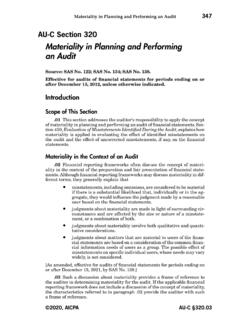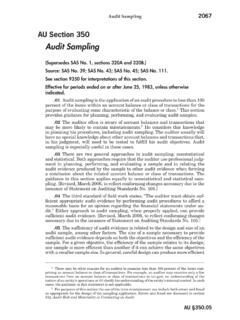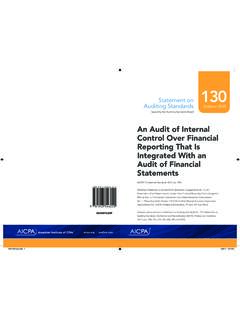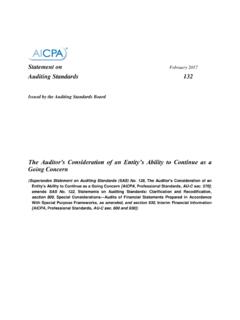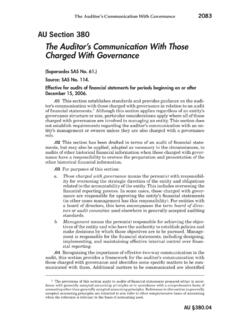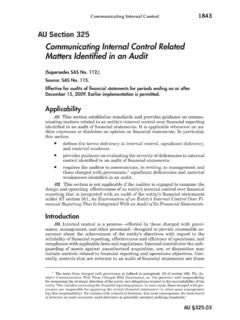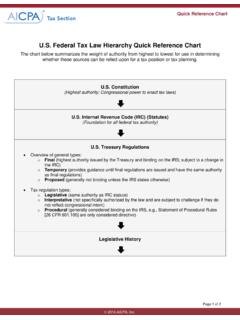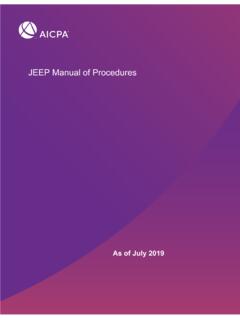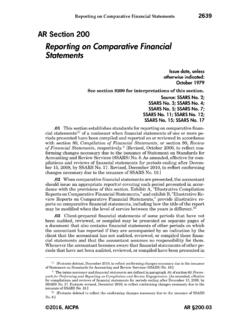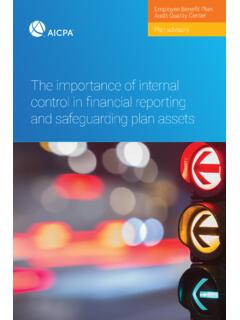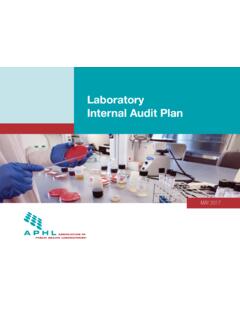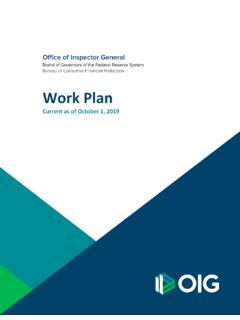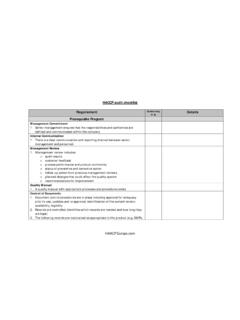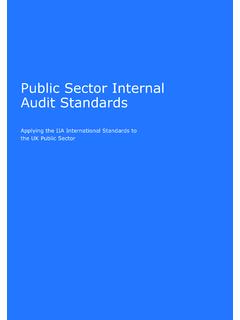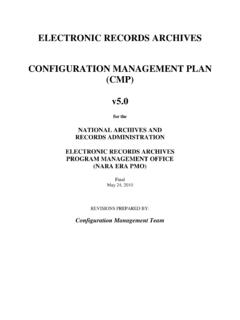Transcription of Limited scope audits - AICPA
1 Employee Benefit plan audit Quality Center plan advisory Limited scope audits of employee benefit plans 01. The AICPA EBPAQC is a firm-based, volunteer membership center created with the goal of promoting quality employee benefit plan audits . Center members demonstrate their commitment to ERISA audit quality by joining and agreeing to adhere to the center's membership requirements. EBPAQC member firms receive valuable ERISA audit and firm best practice tools and resources that are not available from any other source. Visit the center website ( ) to see a list of EBPAQC. member firms and find other valuable tools prepared for plan sponsors and other stakeholders. For more information, contact the EBPAQC at This publication may be freely reproduced and distributed for intra-firm and client service purposes, providing that the reproduced materials is not any way offered for sale or profit.
2 2018 Association of International Certified Professional Accountants. All rights reserved. AICPA and American Institute of CPAs are trademarks of the American Institute of Certified Public Accountants and are registered in the United States, the European Union and other countries. The Globe Design is a trademark owned by the Association of International Certified Professional Accountants and licensed to the AICPA . 22977-374. 02. Contents 2 Introduction 3 Statutory and regulatory basis 4 Qualified institutions 5 Proper certifications 6 The plan administrator's responsibilities for determining the acceptability of a Limited scope certification 8 The auditor's responsibilities for determining whether a certification can be relied upon to limit the scope of the audit 9 The effect on the audit scope and testing 11 Limited scope audits in the current environment 12 The auditor's report 12 Common deficiencies in Limited scope certifications 15 Example Limited scope certification 16 Additional resources 1.
3 Introduction The AICPA Employee Benefit plan audit Quality Center (EBPAQC) prepared this advisory to provide you, the plan sponsor, administrator or trustee, with an understanding of Limited scope audits of employee benefit plans under the Employee Retirement Income Security Act of 1974 (ERISA). Generally, ERISA requires employee benefit plans with 100 or more participants to have an audit as part of their obligation to file an annual return/report (Form 5500 Series). If your employee benefit plan is required to have an audit , in certain circumstances described in this advisory, you have the option to instruct the auditor not to perform any auditing procedures with respect to investment information. This option commonly is referred to as a Limited scope audit .. This advisory describes the statutory and regulatory basis for the Limited scope audit exemption, which institutions are qualified to issue a Limited scope certification, what constitutes a proper certification from a qualified institution, the plan administrator's responsibilities for determining the acceptability of a Limited scope certification, the auditor's responsibilities for determining whether a certification can be relied upon to limit the scope of the audit , the Limited scope audit in the current environment, the effect of the Limited scope audit exemption on the scope of the independent auditor's testing and reporting, and common deficiencies in Limited scope certifications.
4 It also includes an example Limited scope certification. The sponsor of the plan is the plan administrator under the law unless another individual or entity is specifically designated to assume this responsibility. The term plan administrator as used throughout this document refers to the party that is the plan administrator, including a plan sponsor, third-party administrator or trustee. 2. Statutory and regulatory basis In 1974, Congress enacted ERISA to help protect retirement benefits for workers who participate in private pension plans. In addition to establishing minimum standards for benefit accrual, funding and vesting, ERISA section 103(a)(3) required an independent qualified public accountant to audit certain employee benefit plans. However, ERISA section 103(a)(3)(C) allows the plan administrator to instruct the auditor not to perform any auditing procedures with respect to investment information prepared and certified by a bank or similar institution or by an insurance carrier that is regulated, supervised, and subject to periodic examination by a state or federal agency, that acts as trustee or custodian (referred to as qualified institutions ).
5 The Department of Labor (DOL) administers and enforces ERISA's independent audit requirements. The DOL issued implementing regulations in 29 CFR Limitation on scope of accountant's examination, which established regulatory requirements to meet the Limited scope audit exemption. The Securities and Exchange Commission (SEC) does not permit Limited scope audits to be included with Form 11 K filings with the SEC under the Securities Exchange Act of 1934. 3. Qualified institutions Only qualified institutions can certify investment information for the purpose of limiting the scope of an employee benefit plan audit . The DOL established requirements for qualifying institutions to certify information to the plan administrator in 29 CFR 5 Transmittal and certification of information to plan administrator for annual reporting purposes.
6 Under DOL. regulations, investments held by a bank, trust company, or similar institution or by an insurance company that is regulated and subject to periodic examination by a state or Federal agency, and related information do not have to be audited, provided the plan administrator instructs the plan 's independent auditor to perform a Limited scope audit and the institution holding the assets certifies the required information. In an Advisory Opinion to PaineWebber Inc. dated Aug. 3, 1993, the DOL. clarified that an institution must be subjected to routine examinations by a state or Federal agency in order to be considered a qualifying institution for purposes of certifying investment information and, as such, an institution that is not regulated would not qualify: Inasmuch as securities brokerage firms are not regulated, supervised and subject to periodic examination by a state or Federal agency, it is the Department's position that the term similar institution,' as used in 29.
7 8, does not extend to such entities.. Although brokerage firms and investment companies generally would not meet the eligibility requirements for certifying information under the Limited scope audit exemption, some of those institutions may have established separate trust companies that could meet the requirements to be a qualified institution. 4. Proper certifications To meet the requirements for the Limited scope audit exemption, the qualified institution must certify both the completeness and accuracy of the required information, and the certification must be signed, manually or electronically, by a person authorized to represent the institution. 29 CFR provides the following sample certification language for the certifying institution: The XYZ Bank (Insurance Carrier) hereby certifies that the foregoing statement furnished pursuant to 29 CFR (c) is complete and accurate.
8 Certifications that only state the information is either accurate or complete, but not both, or are not signed by an authorized individual, do not meet the DOL requirements for a proper certification. In situations where a Limited scope audit is to be performed on a plan funded under a master trust arrangement or other similar vehicle, the plan administrator would need to obtain separate individual plan certifications from the trustee or the custodian for the allocation of the assets and the related income activity specific to the plan . In some cases, the trustee or custodian may not certify all of the plan 's investment information. For example, the trustee or custodian may exclude investments from the certification, or plan management may change trustees or custodians during the plan year so each trustee or custodian held the assets for part of the year, and only one of the trustees or custodians will certify investment information for part of the year.
9 5. The plan administrator's responsibilities for determining the acceptability of a Limited scope certification Only the plan administrator can request the plan auditor to limit the scope of the audit when all requirements are met. The plan administrator is responsible for determining that the conditions of the Limited scope audit exemption have been met. The DOL reinforced this position in a letter addressed to the AICPA in 2002: Consistent with the obligation of employee benefit plan administrators to file complete and accurate annual reports, it is the responsibility of the administrator to determine whether the conditions for limiting the scope of an accountant's examination, as set forth in ERISA and the department's regulations, have been satisfied.. The plan administrator's responsibility for the plan 's financial statements includes determining that the certification is from a qualified institution and signed by an authorized person, and that the investment information is certified as both complete and accurate.
10 plan administrators should take steps to make sure they understand the nature and scope of the certification the institution has provided before concluding that the certified information may be used to satisfy the administrator's obligation to report the current value of the assets on the plan 's annual report (Form 5500 Series) and in the plan 's financial statements. The DOL observed that if there is a question as to whether a party providing a certification as an authorized representative of a financial institution holding plan assets is in fact authorized to represent the financial entity for this purpose, as may be the case where there is not an explicit statement of authority included as part of the certification, the plan administrator must take steps to resolve this question before authorizing Limited scope reporting.
